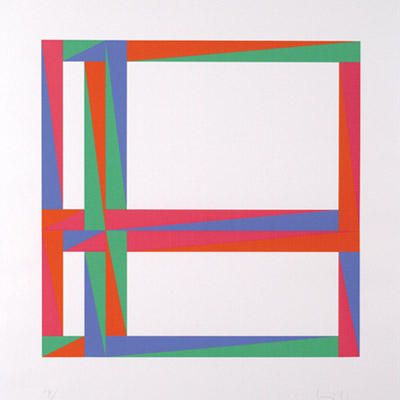Max Bill
by Dean Brownrout
This year marks the 35th anniversary of the important 1974 “Max Bill” exhibition mounted by the Albright-Knox Art Gallery. The show encompassed 50 years of the Swiss-born artist’s work. It was the first major museum retrospective for Bill in this country. Once again the Albright-Knox found acclaim on the national stage.

Max Bill (1908-1994) attended the legendary Bauhaus school in Dessau, Germany in the late 1920s. There, he studied under Paul Klee, Laszlo Moholy-Nagy, Josef Albers, and Wassily Kandinsky.
After leaving the school, Bill went to Paris, and became aligned with the Abstraction-Creation movement. The group was a loose collective of artists who challenged what they perceived as the pervasive influence of Surrealism. Among them were Piet Mondrian, Jean Arp, Auguste Herbin, and several of Bill’s former teachers.
Bill did not limit himself artistically. He was a painter, sculptor, architect, and a graphic and industrial designer.
In the late 1950s, Seymour H. Knox donated several important paintings and sculptures by Bill to the Albright. Buoyed by Knox’s prescience as a collector, the Albright was the only American museum methodically collecting Bill’s work.
In 1972, the members’ council of the Albright-Knox commissioned a limited-edition serigraph directly from Bill. Discussions were underway between the artist and the museum to mount a major exhibition.
James Wood, then an associate director of the gallery, was a curator of the exhibit. Wood, now the president and CEO of the J. Paul Getty Trust, said, “Bill was someone who hadn’t been looked at that seriously in the States. The fact that Seymour Knox was an early Bill supporter made the Albright a logical place to work with the artist.”
The exhibition featured nearly 200 paintings, graphics, and sculptures.
A gorgeous and extensive catalogue and a striking poster complemented the show. Of the process of preparing the event and accompanying materials, Wood said, “Bill was one of these post-Bauhaus individuals who was involved in every aspect of the product design. He had a hand in the whole graphic program; the poster, the screenprint. That was a lot of fun.”
In a laudatory Time magazine review, Robert Hughes called the show “a revelation.”
After its premiere in Buffalo, the exhibition traveled to the Los Angeles County Museum of Art, the San Francisco Museum of Art, and the Corcoran Gallery in Washington, DC.
Bill’s contributions to 20th-century art and other disciplines are now widelyrecognized.
blog comments powered by Disqus|
Issue Navigation> Issue Index > v8n2 (week of Thursday, January 8, 2009) > Max Bill This Week's Issue • Artvoice Daily • Artvoice TV • Events Calendar • Classifieds |









 Current Issue
Current Issue